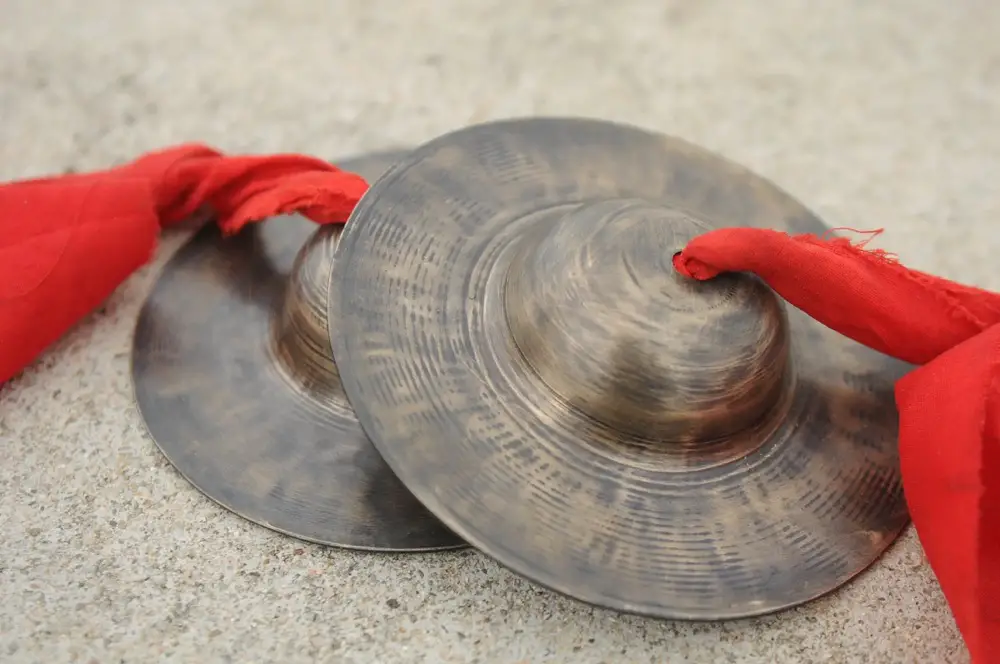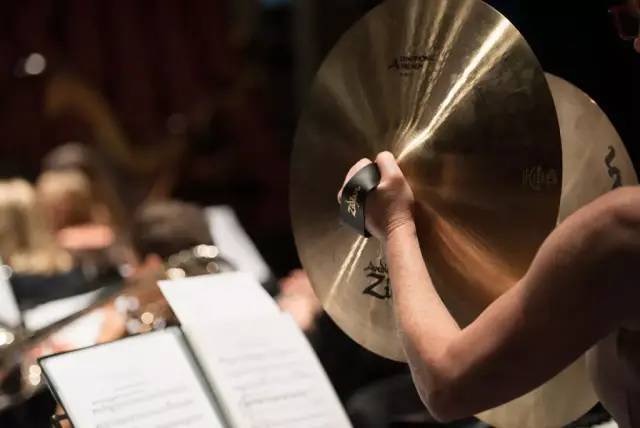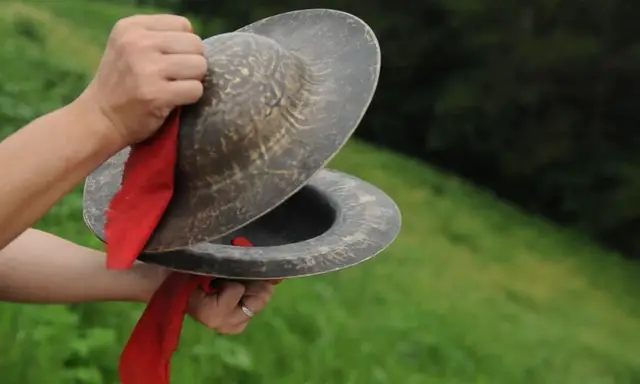When it comes to percussion instruments, drum sets are incomplete without cymbals. Cymbals come in different types and sizes, and one such unique type is the China cymbal. In this article, we will explore what a China cymbal is, what it’s made of, who invented it, and how it differs from a crash cymbal.
What is a Chinese cymbal instrument?

Bo cymbals, also known as “clashing cymbals” or “Chinese hand cymbals,” are a type of percussion instrument frequently featured in Chinese classical music, Chinese opera, and other forms of Chinese performing arts.
Two brass discs are what make up a cymbal, and a strap or ribbon passes through an opening in the middle to hold them together. Cymbals are metal plates that can be struck to produce sound; typically, two are struck together, but single plates can also be used with a stand. Nao is another type of percussion instrument that is similar to the cymbal, and the two are often referred to collectively as “naobao.” During the Shang and Zhou dynasties in ancient China, a bronze percussion instrument with a handle, somewhat like a chime, was commonly used; this instrument later developed into what is now known as a cymbal.
Cymbals and naos are both percussion instruments, but their physical appearance is distinct. In contrast to the nao’s hat-like shape, the cymbal’s grip is larger and more hemispherical, with a flat cymbal face, while the nao’s grip is shaped like a horn. The nao produces a sound that is relatively crisp and lingering, in contrast to the muffled and fleeting sound that the cymbal produces.
Bo cymbals are played by striking two cymbals together while holding one in each hand. Combining them with other percussion instruments like drums and gongs can produce a dynamic and rhythmic sound.
The Bo cymbals add flair to the dramatic moments in a performance of Chinese opera by emphasizing the actors’ movements. The “Bo-da” rhythmic pattern, in which the cymbals are struck rapidly and repeatedly in a set pattern, is commonly used when playing these instruments.
The bo cymbals serve a similar purpose in military music, adding excitement and energy while also punctuating the rhythm. They play a significant role in both classical and contemporary Chinese music and cultural performances.
What is a Chinese cymbal made of?

China cymbals are typically forged from bronze, a copper-tin alloy. The sound of a cymbal can be altered depending on the bronze alloy used in its production. Other metals, such as nickel or silver, may be used in the production of some China cymbals; these additions can further alter the instrument’s sound.
China cymbals are known for their distinct sound, which is due in large part to their distinctive shape. China cymbals have an unusual “upside-down” shape, with a flared lip that curls upward at the edge, as opposed to the flat or slightly curved profiles of most other cymbals. Because of its peculiar shape, the cymbal’s sound is concentrated in its center rather than dispersed uniformly.
It’s not just the cymbal’s shape that determines its sound; the cymbal’s size and thickness do, too. Thicker cymbals have a brighter, more explosive sound, while larger cymbals produce a deeper, more resonant tone.
The use of Chinese cymbals in musical compositions is common when the composer wants to highlight a particular instrument or add drama. Used frequently in heavy metal and punk rock because of their ability to stand out from the rest of the band’s instruments and add a hefty punch, their distinctive sound is often heard in these styles.
What is a china cymbal used for?
Traditional Chinese is used for
The cymbal has a loud and intense sound, with strong penetrating power. It is an essential color percussion instrument in various orchestras and local wind and percussion bands. In local music genres, when used for strong playing, it is extremely powerful and usually expresses a kind of passion; when used for weak playing, its function is similar to that of a bass drum and it belongs to the rhythm instrument category.
During the performance, both hands hold one cymbal each and strike them against each other. There are techniques such as light strikes, heavy strikes, grinding strikes, and slapping strikes. It is used in folk instrumental ensembles, local operas, dance accompaniments, and percussion bands. There is also a single-strike sound, which is produced by striking the edge of a single cymbal with a small stick to obtain a special sound effect. It is used in ethnic bands and as rap accompaniment.
For example, the genre “Fuzhou Pinghua,” which is popular in Fuzhou, Minhou, Yongtai, Lianjiang, Minqing, and other areas of Fujian, uses a single cymbal for accompaniment. The performer holds the lock in the right hand, with a porcelain ring on the thumb, and strikes the edge of the coin to produce sound. The left-hand holds a small stick to beat the rhythm. This is known as the “hit the beat and rap” style. The genre “He Ye,” popular in Sichuan, also uses a single coin for accompaniment. Legend has it that it originated during the Qianlong and Jiaqing periods of the Qing Dynasty and was named after the lock used by actors to strike the beat, which looks like a lotus leaf.
In some regions of China, cymbals and gongs are often essential instruments in funeral customs. Folk big gongs and drums include two forms: “big gongs and drums” and “eight-tone gongs and drums.” The big gongs and drums are completely percussion instruments, with one big drum, four or more horse gongs, and sometimes a pair of small cymbals. The big drum is the leading instrument, playing the rhythm of starting the drum, playing the gong, and stopping the drum. The pattern of the drum beats and sentence structure varies from place to place, but they all strive to be neat and orderly.
band used for
China cymbals, also called “China Boys” or “China Types,” are commonly used in many different musical genres. China cymbals are a favorite of drummers and percussionists of all styles due to their unique tone and appearance.
China cymbals are often used to emphasize dramatic moments in songs. It’s perfect for building tension or excitement because of the cymbal’s distinctive sound, which has a sharp attack and short decay. Whether you’re into rock, metal, jazz, or funk, China cymbals are a great addition to any set.
China cymbals are frequently used to enhance the aggressiveness and power of rock and metal music. They can be played alone or in tandem with other cymbals like crash and ride to produce a rich and varied sound. Sometimes drummers will use a variety of china cymbals, each of a different size, to create a more nuanced and layered effect.
China cymbals are used to create a softer but still recognizable accent in jazz and fusion music. They can heighten the drama or give the piece a new feel. China cymbals are used by jazz drummers in conjunction with other cymbals and percussion instruments like hi-hats, ride cymbals, and tambourines.
China cymbals have a wide range of applications, from traditional music to sound design and film scoring. The cymbal’s distinctive tone can be used to heighten suspense or generate excitement. The unique sound of Chinese cymbals can be used to great effect in more experimental and avant-garde musical compositions.
Who Invented the China Cymbal?

Without a clear inventor or founding myth, the China cymbal’s history is cloudy. It is thought to have originated in China during the Han Dynasty, roughly 2000 years ago (206 BCE–220 CE).
Metalworkers in China may have been inspired to create the first China cymbals after hearing traditional Chinese music performed on large, heavy gongs. They played around with hammering and shaping bronze discs until they got a sound that was uniquely deep, ominous, and sleazy.
The China cymbal gained widespread attention in the early 20th century when it was adopted by Western drummers. Gene Krupa and Chick Webb, two pioneering jazz drummers of the 1920s and 1930s, were responsible for introducing it to Western music by including it as a distinctive accent in their drum kits. In the years since, it’s become a standard in rock, metal, and beyond.
What Is the Difference Between a Crash and a China Cymbal?
Crash cymbals and China cymbals are two common types of cymbals used in drum sets, but they have distinct differences in sound and construction.
Crash cymbals are usually thinner and more rounded than China cymbals. They also have a flatter profile and a more even taper from the center to the edge.This results in a bright, shimmering sound with a quick decay. Crash cymbals are often used for accents and fills in rock, pop, and jazz music.
In contrast, China cymbals have a more pronounced taper from the center to the edge, resulting in a unique shape that curls up at the edges. This gives them a distinctive, trashy sound with a quick, explosive decay. China cymbals are often used for accenting specific beats or adding a touch of aggression or drama to a drum pattern. They are commonly used in metal and hard rock music.
Another difference between crash and China cymbals is in their playing technique. Crash cymbals are typically played with a sweeping motion, using the shoulder of the drumstick to create a full-bodied sound. China cymbals, on the other hand, are often played with a sharp, stabbing motion using the tip of the stick or a brush. This produces a more focused, staccato sound.
In terms of placement on a drum set, crash cymbals are often positioned above the hi-hat and to the left of the drummer, while china cymbals are typically placed to the right of the drummer, above the ride cymbal. However, this can vary depending on the drummer’s personal preferences and the musical style being played.
In the end, a China cymbal is a unique and important part of any drum set. Its gong-like sound and short sustain make it a great cymbal for accents and effects. It’s not clear where it came from, but jazz drummers used it a lot in the early 1900s, which made it a standard in modern music.